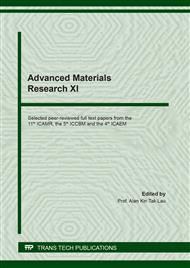[1]
Liu, Lei, et al. Graphene-based polarization-sensitive longwave infrared photodetector., Nanotechnology 30.43 (2019): 435205.
DOI: 10.1088/1361-6528/ab34e4
Google Scholar
[2]
Li, Zhibo, Alasdair W. Clark, and Jonathan M. Cooper. Dual color plasmonic pixels create a polarization controlled nano color palette., Acs Nano 10.1 (2016): 492-498.
DOI: 10.1021/acsnano.5b05411
Google Scholar
[3]
Tassin, Philippe, Thomas Koschny, and Costas M. Soukoulis. Graphene for terahertz applications., Science 341.6146 (2013): 620-621.
DOI: 10.1126/science.1242253
Google Scholar
[4]
Luo, Xiaoguang, et al. Plasmons in graphene: recent progress and applications., Materials Science and Engineering: R: Reports 74.11 (2013): 351-376.
DOI: 10.1016/j.mser.2013.09.001
Google Scholar
[5]
Xiangjun Li, Jian Song, John X.J. Zhang, Design of terahertz metal-dielectric-metal waveguide with microfluidic sensing stub, Optics Communications 361 (2016) 130–137.
DOI: 10.1016/j.optcom.2015.10.007
Google Scholar
[6]
Sensale-Rodriguez, Berardi, et al. Broadband graphene terahertz modulators enabled by intraband transitions., Nature communications 3.1 (2012): 1-7.
DOI: 10.1038/ncomms1787
Google Scholar
[7]
Du, Liang-Hui, et al. A high-performance broadband terahertz absorber based on sawtooth-shape doped-silicon., AIP Advances 6.5 (2016): 055112.
DOI: 10.1063/1.4950800
Google Scholar
[8]
Xu, Gongjie, et al. 0.1–20 THz ultra-broadband perfect absorber via a flat multi-layer structure., Optics express 24.20 (2016): 23177-23185.
DOI: 10.1364/oe.24.023177
Google Scholar
[9]
Yu Liu, Wen Huang, Jing Wang, Renrong Liang, Bin Yu, and Jun Xu, Ultra-Broad and Angle-Sensitive Terahertz Absorber, 978-1-7281-0286-3/19/$31.00 ©2019 IEEE.
DOI: 10.1109/edssc.2019.8754455
Google Scholar
[10]
Tonouchi, Masayoshi. Cutting-edge terahertz technology., Nature photonics 1.2 (2007): 97-105.
DOI: 10.1038/nphoton.2007.3
Google Scholar
[11]
Yao, Yu, et al. High-responsivity mid-infrared graphene detectors with antenna-enhanced photocarrier generation and collection., Nano letters 14.7 (2014): 3749-3754.
DOI: 10.1021/nl500602n
Google Scholar
[12]
Mingbo Pu, Min Wang, Chenggang Hu, Cheng Huang, Zeyu Zhao, Yanqin Wang, and Xiangang Luo, Engineering heavily doped silicon for broadband absorber in the terahertz regime. 20, (2012), 25513-25519.
DOI: 10.1364/oe.20.025513
Google Scholar
[13]
Tang, Weiwei, et al. Ultrasensitive Room‐Temperature Terahertz Direct Detection Based on a Bismuth Selenide Topological Insulator., Advanced Functional Materials 28.31 (2018): 1801786.
DOI: 10.1002/adfm.201801786
Google Scholar
[14]
Liu, Mingkai, et al. Ultrathin tunable terahertz absorber based on MEMS-driven metamaterial., Microsystems & nanoengineering 3.1 (2017): 1-6.
Google Scholar


